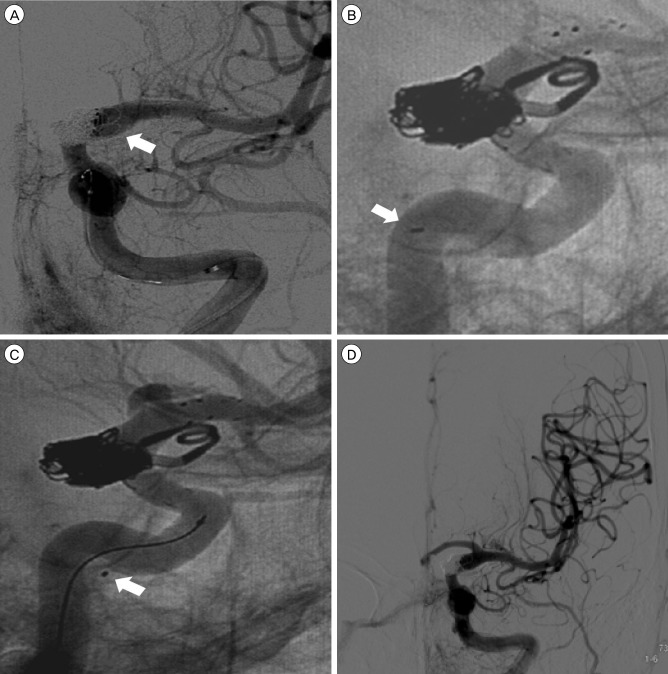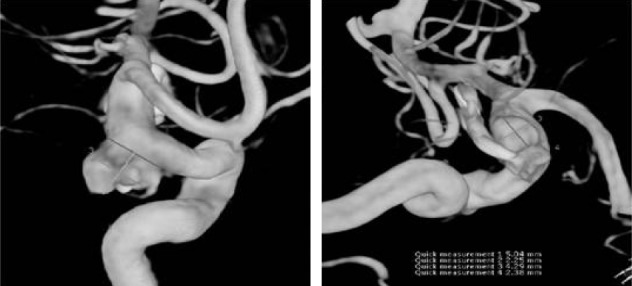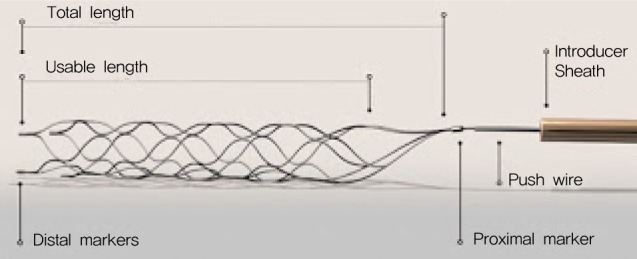1. Akpek S, Arat A, Morsi H, Klucznick RP, Strother CM, Mawad ME. Self-expandable stent-assisted coiling of wide-necked intracranial aneurysms: a single-center experience. AJNR Am J Neuroradiol. 2005; 5. 26(5):1223–1231. PMID:
15891189.
2. Amagasaki K, Higa T, Takeuchi N, Kakizawa T, Shimizu T. Late recurrence of subarachnoid hemorrhage due to regrowth of aneurysm after neck clipping surgery. Neurol Med Chir (Tokyo). 002; 11. 42(11):496–500. PMID:
12472214.
3. Barrow DL, Spector RH, Braun IF, Landman JA, Tindall SC, Tindall GT. Classification and treatment of spontaneous carotid-cavernous sinus fistulas. J Neurosurg. 1985; 2. 62(2):248–256. PMID:
3968564.

4. Benndorf G, Bender A, Lehmann R, Lanksch W. Transvenous occlusion of dural cavernous sinus fistulas through the thrombosed inferior petrosal sinus: report of four cases and review of the literature. Surg Neurol. 2000; 7. 54(1):42–54. PMID:
11024506.

5. Biondi A, Milea D, Cognard C, Ricciardi GK, Bonneville F, van Effenterre R. Cavernous sinus dural fistulae treated by transvenous approach through the facial vein: report of seven cases and review of the literature. AJNR Am J Neuroradiol. 2003; Jun-Jul. 24(6):1240–1246. PMID:
12812963.
6. Bujak M, Margolin E, Thompson A, Trobe JD. Spontaneous resolution of two dural carotid-cavernous fistulas presenting with optic neuropathy and marked congestive ophthalmopathy. J Neuroophthalmol. 2010; 9. 30(3):222–227. PMID:
20498622.

7. Cekirge H, Islak C, Firat M, Kocer N, Saatci I. Endovascular coil embolization of residual or recurrent aneurysms after surgical clipping. Acta Radiol. 2000; 3. 41(2):111–115. PMID:
10741780.

8. Giannotta SL, Litofsky NS. Reoperative management of intracranial aneurysms. J Neurosurg. 1995; 9. 83(3):387–393. PMID:
7666212.

9. Gupta AK, Purkayastha S, Krishnamoorthy T, Bodhey NK, Kapilamoorthy T, Kesavadas C, et al. Endovascular treatment of direct carotid cavernous fistulae: a pictorial review. Neuroradiology. 2006; 11. 48(11):831–839. PMID:
16969673.

10. Horowitz M, Levy E, Sauvageau E, Genevro J, Guterman LR, Hanel R, et al. Intra/extra-aneurysmal stent placement for management of complex and wide-necked-bifurcation aneurysms: eight cases using the waffle cone technique. Neurosurgery. 2006; 4. 58(4 Suppl 2):ONS-258-62.
11. Kanamalla US, Jungreis CA, Kochan JP. Direct carotid cavernous fistula. In : Hurst RW, Rosenwasser RH, editors. Interventional Neuroradiology. New York: Informa healthcare;2008. p. 231–238.
12. Klisch J, Eger C, Sychra V, Strasilla C, Basche S, Weber J. Stent-Assisted Coil Embolization of Posterior Circulation Aneurysms Using Solitaire Ab: Preliminary Experience. Neurosurgery. 2009; 8. 65(2):258–266. PMID:
19625903.
13. Kwon HJ, Jin SC. Spontaneous healing of iatrogenic direct carotid cavernous fistula. Interv Neuroradiol. 2012; 6. 18(2):187–190. PMID:
22681734.

14. Lanzino G, Wakhloo AK, Fessler RD, Hartney ML, Guterman LR, Hopkins LN. Efficacy and current limitations of intravascular stents for intracranial internal carotid, vertebral, and basilar artery aneurysms. J Neurosurg. 1999; 10. 91(4):538–546. PMID:
10507372.

15. Lee YJ, Kim DJ, Suh SH, Lee SK, Kim J, Kim DI. Stent-assisted coil embolization of intracranial wide-necked aneurysms. Neuroradiology. 2005; 9. 47(9):680–689. PMID:
16028036.

16. Liebig T, Henkes H, Reinartz J, Miloslavski E, Kühne D. A novel self-expanding fully retrievable intracranial stent (SOLO): experience in nine procedures of stent-assisted aneurysm coil occlusion. Neuroradiology. 2006; 7. 48(7):471–478. PMID:
16758153.

17. Nishijima M, Iwai R, Horie Y, Oka N, Takaku A. Spontaneous occlusion of traumatic carotid cavernous fistula after orbital venography. Surg Neurol. 1985; 5. 23(5):489–492. PMID:
3983805.

18. Park HR, Yoon SM, Shim JJ, Kim SH. Waffle-cone technique using Solitaire AB stent. J Korean Neurosurg Soc. 2012; 4. 51(4):222–226. PMID:
22737303.

19. Rabinstein AA, Nichols DA. Endovascular coil embolization of cerebral aneurysm remnants after incomplete surgical obliteration. Stroke. 2002; 7. 33(7):1809–1815. PMID:
12105358.

20. Rahal JP, Dandamudi VS, Safain MG, Malek AM. Double waffle-cone technique using twin Solitaire detachable stents for treatment of an ultra-wide necked aneurysm. J Clin Neurosci. 2013; 6. 21(6):1019–1023. PMID:
24412295.

21. Reider-Grosswasser I, Loewenstein A, Gaton DD, Lazar M. Spontaneous thrombosis of a traumatic cavernous sinus fistula. Brain Inj. 1993; 11. 7(6):547–550. PMID:
8260959.

22. Sluzewski M, Van Rooij WJ, Beute GN, Nijssen PC. Balloon-assisted coil embolization of intracranial aneurysms: incidence, complications, and angiography results. J Neurosurg. 2006; 9. 105(3):396–399. PMID:
16961133.

23. Sychra V, Klisch J, Werner M, Dettenborn C, Petrovitch A, Strasilla C, et al. Waffle-cone technique with Solitaire™ AB Remodeling Device: endovascular treatment of highly selected complex cerebral aneurysms. Neuroradiology. 2011; 12. 53(12):961–972. PMID:
20821314.

24. Tjoumakaris SI, Jabbour PM, Rosenwasser RH. Neuroendovascular management of carotid cavernous fistulae. Neurosurg Clin N Am. 2009; 10. 20(4):447–452. PMID:
19853804.

25. Vanninen R, Manninen H, Ronkainen A. Broad-based intracranial aneurysms: thrombosis induced by stent placement. AJNR Am J Neuroradiol. 2003; 2. 24(2):263–266. PMID:
12591645.
26. Voigt K, Sauer M, Dichgans J. Spontaneous occlusion of a bilateral caroticocavernous fistula studied by serial angiography. Neuroradiology. 1971; 9. 2(4):207–211. PMID:
5164129.

27. Wanke I, Doerfler A, Schoch B, Stolke D, Forsting M. Treatment of wide-necked intracranial aneurysms with a self-expanding stent system: initial clinical experience. AJNR Am J Neuroradiol. 2003; Jun-Jul. 24(6):1192–1199. PMID:
12812954.
28. Wanke I, Forsting M. Stents for intracranial wide-necked aneurysms: more than mechanical protection. Neuroradiology. 2008; 12. 50(12):991–998. PMID:
18807024.

29. Yavuz K, Geyik S, Pamuk AG, Koc O, Saatci I, Cekirge HS. Immediate and midterm follow-up results of using an electrodetachable, fully retrievable SOLO stent system in the endovascular coil occlusion of wide-necked cerebral aneurysms. J Neurosurg. 2007; 7. 107(1):49–55. PMID:
17639873.

30. Yoon KW, Kim YJ. In-stent stenosis of stent assisted endovascular treatment on intracranial complex aneurysms. J Korean Neurosurg Soc. 2010; 12. 48(6):485–489. PMID:
21430973.







 PDF
PDF ePub
ePub Citation
Citation Print
Print





 XML Download
XML Download